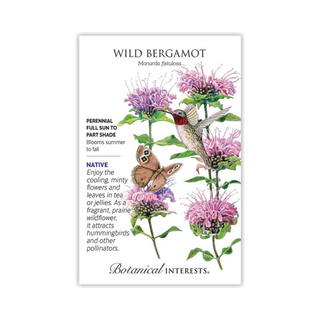
Description
Native to U.S. prairies, this heirloom is also known as monarda, horsemint, wild bee balm, and Oswego tea (because of its use by Native Americans). Its complex flavor is a combination of oregano, thyme, and mint; a unique seasoning for jellies, salads, and other savory dishes. The showy, pinkish-lavender flowers bloom all summer to the delight of bees, hummingbirds, and butterflies, the wood nymph butterfly in particular. Adaptable to short periods of drought and poor soils and resistant to mildew. Perennial in USDA zones 3 to 9. Deer resistant.
Variety Info
- Family: Lamiaceae
- Native: Most of North America east of the Rocky Mountains
- Hardiness: Perennial in USDA zones 3–9
- Exposure: Full Sun to Part Shade
- Bloom Period: Summer to fall
- Plant Dimensions: 36"–48" tall and about 18"–24" wide
- Variety Info: Pink to light-lavender, ¾"–1¼" florets are arranged in a whorl around a pincushion-like center, creating a 2"–4" flattened pom-pom-shaped flower
- Attributes: Attracts Butterflies, Attracts Hummingbirds, Attracts Pollinators, Cut Flower, Deer Resistant, Drought Tolerant, Edible Flower, Heat Tolerant
Sowing Info
- When to Sow Outside: 2 to 4 weeks before your average last frost date or in late summer to fall.
- When to Start Inside: RECOMMENDED. 8 to 10 weeks before your average last frost date.
- Days to Emerge: 14 – 21 Days
- Seed Depth: Surface to 1/16"
- Seed Spacing: A group of 5 seeds every 18"–24"
- Thinning: When 1" tall, thin to 1 every 18"–24"
Growing Info
- Harvesting: For longest vase life, cut stems when one ring of florets has opened. Change vase water often.
Description
Native to U.S. prairies, this heirloom is also known as monarda, horsemint, wild bee balm, and Oswego tea (because of its use by Native Americans). Its complex flavor is a combination of oregano, thyme, and mint; a unique seasoning for jellies, salads, and other savory dishes. The showy, pinkish-lavender flowers bloom all summer to the delight of bees, hummingbirds, and butterflies, the wood nymph butterfly in particular. Adaptable to short periods of drought and poor soils and resistant to mildew. Perennial in USDA zones 3 to 9. Deer resistant.
Variety Info
- Family: Lamiaceae
- Native: Most of North America east of the Rocky Mountains
- Hardiness: Perennial in USDA zones 3–9
- Exposure: Full Sun to Part Shade
- Bloom Period: Summer to fall
- Plant Dimensions: 36"–48" tall and about 18"–24" wide
- Variety Info: Pink to light-lavender, ¾"–1¼" florets are arranged in a whorl around a pincushion-like center, creating a 2"–4" flattened pom-pom-shaped flower
- Attributes: Attracts Butterflies, Attracts Hummingbirds, Attracts Pollinators, Cut Flower, Deer Resistant, Drought Tolerant, Edible Flower, Heat Tolerant
Sowing Info
- When to Sow Outside: 2 to 4 weeks before your average last frost date or in late summer to fall.
- When to Start Inside: RECOMMENDED. 8 to 10 weeks before your average last frost date.
- Days to Emerge: 14 – 21 Days
- Seed Depth: Surface to 1/16"
- Seed Spacing: A group of 5 seeds every 18"–24"
- Thinning: When 1" tall, thin to 1 every 18"–24"
Growing Info
- Harvesting: For longest vase life, cut stems when one ring of florets has opened. Change vase water often.

